davewindowcleaner
Well-known member
- Messages
- 691
- Location
- London
Met a jamaican window cleaner (nice chap) using a 1mm pencil jets.
Told me using 1mm save him a lot of water plus it great for cleaning top frames above the windows cos he find 2mm & 3mm jets can cause a few big drip on the glass leaving white spots.
1mm jets don't caused dripping onto the glass according to him the wet drip are smaller, stay on the frame & dry out.
Anyway I didn't ask him where he got 1mm jets from, I though I could easily find one online.
The smallish pencil jets I can find are 1.4mm from Gardiner. Anyone got 1mm jets and where did u get it from cos I like to tried see what it like?
Told me using 1mm save him a lot of water plus it great for cleaning top frames above the windows cos he find 2mm & 3mm jets can cause a few big drip on the glass leaving white spots.
1mm jets don't caused dripping onto the glass according to him the wet drip are smaller, stay on the frame & dry out.
Anyway I didn't ask him where he got 1mm jets from, I though I could easily find one online.
The smallish pencil jets I can find are 1.4mm from Gardiner. Anyone got 1mm jets and where did u get it from cos I like to tried see what it like?




























